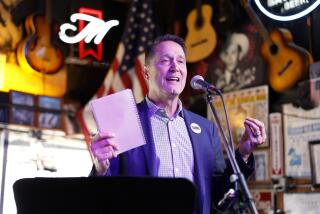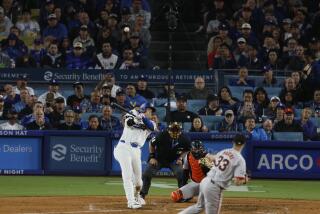Forgers pitching a fast one to the unsuspecting
- Share via
Hockey great Cam Neely remembers the time a few years back when he walked into an Atlanta sports bar and was told that one of his jerseys held a place of honor on the wall. Not only that, it was one he’d autographed.
There was only one problem: Neely had never signed it.
Barry Halper, a minority owner of the New York Yankees, who at one time owned the best sports memorabilia collection in the world, tells this story: He was approached by a man who wanted to sell him a letter from Lou Gehrig, one of baseball’s greatest players. Halper took one look and knew it was a fake. The letterhead contained a ZIP Code that wasn’t introduced until 1963, more than 20 years after Gehrig’s death. And if any more evidence were needed, Gehrig purportedly wrote that he believed the Yankees would repeat as winners of the American League East, which didn’t even exist at the time.
Autograph forgery, even when done badly, is a crime so pervasive in sports and entertainment that the odds of getting a genuine signature make blackjack look like a sure thing. There are so many Tiger Woods forgeries out there, for instance, that the chance of getting a real signature is now put at 1 in 10.
In days gone by, when autographs had little value, forgery was a rarity. But now that a signature can sell for thousands of dollars, the crooks have moved in and made a shambles of the market. The advice experts give is to eyeball the autograph being signed. If unsure, presume a signature is a fake until it’s proved otherwise. And if something seems too good to be true, think forgery. Don’t think you’re getting a deal spending $500 on a baseball autographed by Babe Ruth; the going rate for an authentic one in mint condition is more than $10,000.
“They’re a shameless bunch of people who don’t have any trouble sleeping at night,” James Spence, a leading expert in sports autographs, said of forgers.
And as much as forgeries have taken over in sports collecting, the Hollywood end of the business is even more cluttered with fakes. “The big celebrities, they don’t do signings,” said FBI agent Tim Fitzsimmons. “But if you go online, you can get any big celebrity you want in any quantity. It’s all bad.”
At one time, autographs were collected by children and die-hard fans, people willing to wait for hours to get a signature on a program or a scrap of paper. But in the last 20 years, all that has changed as the sports autograph business alone has burgeoned into a $500-million industry. And the main driving force is the Internet, where millions of trading cards and memorabilia are sold.
Huge online volume
On EBay, the online auction house, about 350,000 trading cards are put up for bid each week. That does not include the thousands of other items with signatures on them. With that kind of volume, policing is a near-impossible nightmare. Realizing its reputation was suffering as it became a major marketplace for forgeries, EBay recently signed a deal with Professional Sports Authenticators, a company based in Newport Beach, aimed at giving collectors a fighting chance. For a $7.49 fee, the company will deliver an opinion within 36 hours about whether a signature is probably good or probably fake, but with no guarantees. The buyer is still on his own when it comes to making a decision.
“We’re trying to arm people with the knowledge and power to make an intelligent decision,” said EBay’s John Fitch, who heads the auction house’s trading card and memorabilia division. EBay wouldn’t disclose dollar figures for autographs sold but projected that all sports-related sales this year would come to $1 billion.
Trading-card manufacturer Upper Deck has taken a different approach to guaranteeing signature authenticity. When a star athlete under contract to the company does a signing, the entire session is filmed on what the company calls a pen-cam. The small camera attached to a pen records the signing. The buyer gets a CD-ROM of the actual autograph session, complete with a permanent digital date and time stamp.
“It’s the real McCoy,” said Upper Deck spokeswoman Mary Macera. “What we always recommend is that if you can meet an athlete face to face, go for it. If you can’t do that, then you really have to be smart about what you’re buying.”
Unfortunately, say the experts, most people are downright ignorant when it comes to buying signatures of their favorite athletes or movie stars. Many are happy with a certificate of authenticity, which often isn’t worth the paper it’s printed on. Others simply take it on faith that a signature is genuine, even though the odds are against it.
“It’s the willingness of people to believe that’s so incredible,” said forgery expert Kenneth Rendell, whose book, “Forging History: The Detection of Fake Letters and Documents,” is considered one of the best on the subject.
Or as Philadelphia autograph dealer Steven Raab put it: “This has brought scads of disreputable people onto the scene. You can make a great living selling forged autographs.”
While fake autographs are a big business, dealers complain that the crime is generally ignored by most law enforcement agencies because, taken individually, most forgeries are small potatoes. The only major autograph bust came in 1999, when the FBI ran what was known as Operation Bullpen, led by Fitzsimmons, based in San Diego. Forty people were arrested and charged in the case, whose evidence included recordings of forgers laughing as they signed bogus names on various sports paraphernalia. Tom Kramer, owner of Golden Age Autographs in New York, said one of the problems is that with new technology it’s almost impossible to tell the fake from the real. Kramer, who specializes in vintage Hollywood photos, said forgers can shoot a picture of a real signature, overlay it on a photo and then expertly trace the name.
“It’s very difficult to prove that a lot of this material is fake because it looks so good,” he said. “One rule for dealers is that if you see something that you’ve never seen before and it looks a little too good to be true, you’re going to pause and look more closely.”
Added to this mix is the fact that Hollywood stars often have a battery of assistants whose job is to sign celebrity photos and send them to fans. Los Angeles autograph expert Chuck Sachs said that at any given time, for instance, actor Clint Eastwood has several secretaries on hand who can imitate his autograph.
“What do I do when I see Clint Eastwood material?” he asked. “I head for the hills.”
Rendell agreed: “People have to have a suspension of disbelief to be buying movie stars. Do they really think they sit around signing this stuff?”
One other culprit of signature authenticity is the autopen, the automated device often used by heads of state and other dignitaries to sign thousands of documents that come with the job. The trouble is, it doesn’t count as the real thing in the autograph world. Washington signature expert Edward Bomsey said one of the most common autographs people take to him is that of John F. Kennedy.
“Ninety-nine times out of a 100 it’s a secretary’s signature or a machine signature,” he said. “People have kept these items like they are a sacred relic. When they bring them in for appraisal, it breaks your heart.”
Kennedy also figured in a 1997 hoax in which forged documents purported to prove the former president had an affair with actress Marilyn Monroe, then paid her mother $600,000 in hush money. One of the proofs of forgery was that the typewriter used to compose the documents didn’t come on the market until eight years after Kennedy’s death.
While such bumbling does happen, forgers have proved themselves to be a crafty lot. They have been known to create their own ink so that it appears aged. A New Hampshire man was recently arrested for cutting out the pages of antique books, then using the blank areas to forge signatures of old time stars and sports figures. That way, the age of the paper matched the era of the supposed signer. More often than not, such a forged signature is then lavishly framed, complete with a picture of the celebrity, giving it an aura of authenticity.
An infamous forger
Sometimes forgeries rise from the dead after being out of circulation for generations. The most recent dupe occurred in May at a Philadelphia auction house that was selling manuscripts attributed to Francis Hopkinson, a signer of the Declaration of Independence.
But the material had to be pulled when it was discovered that it was the work of infamous forger “Baron” Charles B. Weisberg, who died in prison in 1945. The forgeries were found in a forgotten basement box and were then authenticated as real. Only at the last minute did the auction house realize they were forged by Weisberg, known for his skilled fakes of Stephen Foster manuscripts as well as the letters of Lincoln and Washington.
The question of authenticity made the news last summer after Boston Red Sox slugger Ted Williams died. Shortly after his death, a smudged note bearing Williams’ signature requested that the baseball great be preserved cryonically. The note, also signed by Williams’ son, John Henry, and daughter, Claudia, caused much speculation in autograph circles that the signature could be a forgery because it contradicted Williams’ 1996 will.
So what’s to be done? Spence said education is the first priority; knowing, for instance, that a newer brand of baseball couldn’t have been signed by a long-dead player. “A lot of forgers don’t know anything about the history of baseball,” said Spence. “They’re just opportunists.”
He also said buyers should try to pay by credit card because redress is sometimes possible if fraud is discovered. Finally, he said there should be an expert authentication, with the buyer paying the fee if the item is authentic, the seller paying if it’s a fraud. And, Spence said, if the seller balks, don’t buy.
The FBI’s Fitzsimmons said one of the most important things is to know the history, or provenance, of a signature and not take certificates of authentication as sufficient proof. “They just print those certificates,” he said. “The provenance is more important.”
More to Read
Go beyond the scoreboard
Get the latest on L.A.'s teams in the daily Sports Report newsletter.
You may occasionally receive promotional content from the Los Angeles Times.










